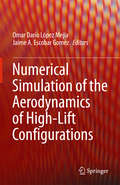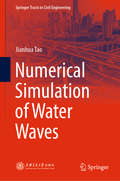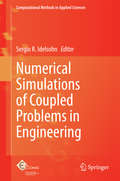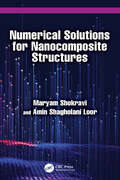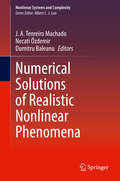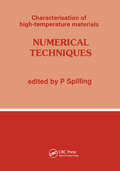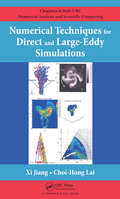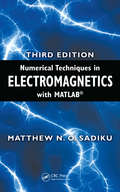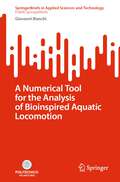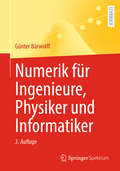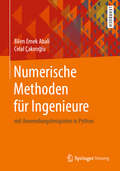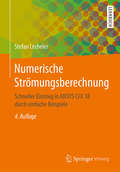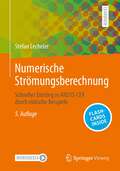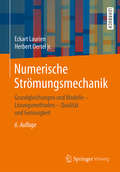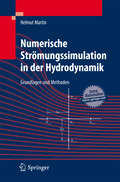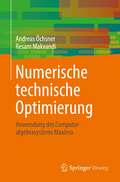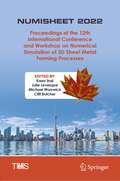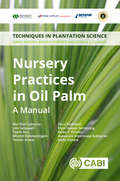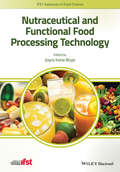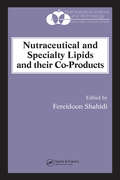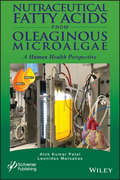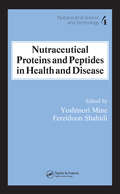- Table View
- List View
Numerical Simulation of the Aerodynamics of High-Lift Configurations
by Omar Darío López Mejia Jaime A. Escobar GomezThis book deals with numerical simulations and computations of the turbulent flow around high-lift configurations commonly used in aircraft. It is devoted to the Computational Fluids Dynamics (CFD) method using full Navier-Stokes solvers typically used in the simulation of high-lift configuration. With the increase of computational resources in the aeronautical industry, the computation of complex flows such as the aerodynamics of high-lift configurations has become an active field not only in academic but also in industrial environments. The scope of the book includes applications and topics of interest related to the simulation of high-lift configurations such as: lift and drag prediction, unsteady aerodynamics, low Reynolds effects, high performance computing, turbulence modelling, flow feature visualization, among others. This book gives a description of the state-of-the-art of computational models for simulation of high-lift configurations. It also shows and discusses numerical results and validation of these computational models. Finally, this book is a good reference for graduate students and researchers interested in the field of simulation of high-lift configurations.
Numerical Simulation of Water Waves (Springer Tracts in Civil Engineering)
by Jianhua TaoThis book discusses the numerical simulation of water waves, which combines mathematical theories and modern techniques of numerical simulation to solve the problems associated with waves in coastal, ocean, and environmental engineering. Bridging the gap between practical mathematics and engineering, the book describes wave mechanics, establishment of mathematical wave models, modern numerical simulation techniques, and applications of numerical models in engineering. It also explores environmental issues related to water waves in coastal regions, such as pollutant and sediment transport, and introduces numerical wave flumes and wave basins. The material is self-contained, with numerous illustrations and tables, and most of the mathematical and engineering concepts are presented or derived in the text. The book is intended for researchers, graduate students and engineers in the fields of hydraulic, coastal, ocean and environmental engineering with a background in fluid mechanics and numerical simulation methods.
Numerical Simulations of Coupled Problems in Engineering
by Sergio R. IdelsohnThis book presents and discusses mathematical models, numerical methods and computational techniques used for solving coupled problems in science and engineering. It takes a step forward in the formulation and solution of real-life problems with a multidisciplinary vision, accounting for all of the complex couplings involved in the physical description. Simulation of multifaceted physics problems is a common task in applied research and industry. Often a suitable solver is built by connecting together several single-aspect solvers into a network. In this book, research in various fields was selected for consideration: adaptive methodology for multi-physics solvers, multi-physics phenomena and coupled-field solutions, leading to computationally intensive structural analysis. The strategies which are used to keep these problems computationally affordable are of special interest, and make this an essential book.
Numerical Solutions for Nanocomposite Structures
by Maryam Shokravi Amin Shagholani LoorNumerical Solutions for Nanocomposite Structures provides an in-depth exploration of structural analysis using numerical methods grounded in rigorous mathematical modeling. Theoretical foundations are established by comprehensively elucidating theories governing beams, plates, and shells, leading to the derivation of governing equations based on the stress–strain relationship. The process of obtaining governing equations through the energy method, application of boundary conditions, and the utilization of numerical methods to calculate deflection, frequency, and buckling loads is meticulously explained, providing readers with valuable insights into structural analysis methodologies. Includes diverse numerical examples involving beams, plates, and pipes, providing a comprehensive understanding of underlying theories and relationships. Provides numerous practical examples demonstrating the application of numerical methods to address challenges in civil and mechanical engineering problems. Discusses the unique mechanical, thermal, and electrical properties of nanocomposites, and how they can be utilized in various industries.
Numerical Solutions of Realistic Nonlinear Phenomena (Nonlinear Systems and Complexity #31)
by Dumitru Baleanu J. A. Tenreiro Machado Necati ÖzdemirThis collection covers new aspects of numerical methods in applied mathematics, engineering, and health sciences. It provides recent theoretical developments and new techniques based on optimization theory, partial differential equations (PDEs), mathematical modeling and fractional calculus that can be used to model and understand complex behavior in natural phenomena. Specific topics covered in detail include new numerical methods for nonlinear partial differential equations, global optimization, unconstrained optimization, detection of HIV- Protease, modelling with new fractional operators, analysis of biological models, and stochastic modelling.
Numerical Techniques
by P. SpillingThis volume includes the proceedings of the Seventh Seminar in a Series Sponsored and Organised by the Materials Science, Materials Engineering and Continuing Education Committees of the Institute of Metals held in London on 6 December 1989. This seventh and last volume in the series attempts to review some of the many areas in which numerical methods can be applied as basic tools for the solution of metallurgical problems and to provide a grounding in the principles involved.
Numerical Techniques for Direct and Large-Eddy Simulations (Chapman & Hall/CRC Numerical Analysis and Scientific Computing Series)
by Xi Jiang Choi-Hong LaiCompared to the traditional modeling of computational fluid dynamics, direct numerical simulation (DNS) and large-eddy simulation (LES) provide a very detailed solution of the flow field by offering enhanced capability in predicting the unsteady features of the flow field. In many cases, DNS can obtain results that are impossible using any other me
Numerical Techniques in Electromagnetics with MATLAB (Third Edition)
by Matthew N.O. Sadiku<p>Despite the dramatic growth in the availability of powerful computer resources, the EM community lacks a comprehensive text on the computational techniques used to solve EM problems. The first edition of Numerical Techniques in Electromagnetics filled that gap and became the reference of choice for thousands of engineers, researchers, and students. <p>This third edition of the bestselling text reflects the continuing increase in awareness and use of numerical techniques and incorporates advances and refinements made in recent years. Most notable among these are the improvements made to the standard algorithm for the finite-difference time-domain (FDTD) method and treatment of absorbing boundary conditions in FDTD, finite element, and transmission-line-matrix methods. The author also has added a chapter on the method of lines. <p>Numerical Techniques in Electromagnetics with MATLAB®, Third Edition continues to teach readers how to pose, numerically analyze, and solve EM problems, to give them the ability to expand their problem-solving skills using a variety of methods, and to prepare them for research in electromagnetism. Now the Third Edition goes even further toward providing a comprehensive resource that addresses all of the most useful computation methods for EM problems and includes MATLAB code instead of FORTRAN.</p>
A Numerical Tool for the Analysis of Bioinspired Aquatic Locomotion (SpringerBriefs in Applied Sciences and Technology)
by Giovanni BianchiThis book presents a novel method for the numerical simulation of swimming animals. It includes a review of the hydrodynamics of swimming, a description of the CFD model adopted, and a description of the results obtained by applying this model to the cownose ray. This method is developed for the open-source software OpenFOAM and relies on an overset mesh. A custom library is added to the solver to include the equations of the kinematics of the animal under investigation, combining the deformation of the fish fins with the computed displacement and rotation of the animal's body. The presented method helps investigate the dynamics of any animal moving in a fluid, provided that its kinematics is known, and in this work, it is applied to investigate the hydrodynamics of a cownose ray. This book is intended for researchers and engineers who aim to deeply understand the hydrodynamics of fish swimming and to design bioinspired autonomous underwater vehicles or novel propulsion systems.
Numerik für Ingenieure, Physiker und Informatiker
by Günter BärwolffDieses Lehrbuch wendet sich hauptsächlich an Studierende der Ingenieur- und Naturwissenschaften sowie der Informatik, aber auch an in der angewandten Praxis tätige Absolventen dieser Disziplinen. Es wird ein weites Spektrum von verschiedenen Themenfeldern behandelt, von der numerischen Lösung linearer Gleichungssysteme über Eigenwertprobleme, numerische Integration bis hin zu gewöhnlichen und partiellen Differentialgleichungen. Dabei werden jeweils die Methoden diskutiert, die den spezifischen Anforderungen typischer Aufgabenstellungen in der Praxis entsprechen. Der Autor stellt die Themen in einer Weise dar, die sowohl den wesentlichen mathematischen Hintergrund klarmacht, als auch eine unkomplizierte Umsetzung auf praktische Aufgabenstellungen bzw. die Realisierung auf dem Computer ermöglicht. Vorausgesetzt werden beim Leser lediglich Grundkenntnisse in der Höheren Mathematik, wie sie im Grundstudium für die genannten Fachrichtungen vermittelt werden, wobei einige wichtige Aussagen aus Analysis und linearer Algebra wiederholt werden. Zu den behandelten Methoden werden octave-Programme angegeben und zum Download angeboten, so dass der Leser in die Lage versetzt wird, konkrete Aufgabenstellungen zu bearbeiten. Mehr als 60 Übungsaufgaben mit Lösungen im Internet erleichtern die Aneignung des Lernstoffes.Die vorliegende 3. Auflage ist vollständig durchgesehen und um ein Kapitel zur numerischen Lösung stochastischer Differentialgleichungen ergänzt.
Numerische Auslegung von Wälzlagern
by Hung Nguyen-SchäferDieses Buch beschreibt die numerische Auslegung von Wälzlagern in verständlicher Weise. Dabei werden unterschiedliche interdisziplinäre Arbeitsfelder behandelt, wie z.B. die Hertzsche Kontakttheorie, die Elastohydrodynamik (EHD) für sehr dünne Schmierfilmdicken, Wälzlagerkinematik, Tribologie der Oberflächenstrukturen, Materialermüdung oder die Lebensdauer der Wälzlager und Schmierfette (-öle) anhand der Weibull-Verteilung. Weitere Themen sind Lagerversagensmechanismen, das Rotorauswuchten und induzierte Lärmverminderung (NVH Noise, Vibration, Harshness) in Wälzlagern. Darüber hinaus findet der Leser viele wichtige Formeln nach DIN/ISO-Normen, die für die numerische Auslegung von Wälzlagern sehr hilfreich sind. Das Buch fördert das Verständnis der Wechselwirkungen zwischen den genannten Themen und ermöglicht so eine effizientere Auslegung von Wälzlagern für die Automobilentwicklung und andere Industriezweige.
Numerische Methoden der Technischen Akustik (Fachwissen Technische Akustik)
by Michael Möser Gerhard MüllerDieser Band der Reihe Fachwissen Technische Akustik behandelt die am weitesten verbreiteten, wellentheoretischen Verfahren der numerischen Akustik. Die Randelementemethode, die Finite-Elemente-Methode und die Ersatzstrahlermethode werden in den Kapiteln ausführlich behandelt. Weitere Methoden wie z. B. Approximationen für hohe Frequenzen, Verfahren der geometrischen Akustik oder die statistische Energieanalyse werden ebenfalls kurz angesprochen.
Numerische Methoden für Ingenieure: mit Anwendungsbeispielen in Python
by Bilen Emek Abali Celal ÇakıroğluTechnische Systeme werden von Ingenieur*innen modelliert und durch numerische Methoden simuliert. Dieses Lehrbuch bietet eine unkomplizierte Einführung in numerische Methoden, mit zahlreichen, praxisrelevanten Beispielen, die mithilfe der Programmiersprache Python gelöst werden. In ingenieurwissenschaftlichen Studienrichtungen sowie in allen Forschungsprojekten sind numerische Simulationen unumgänglich, geeignete Methoden aber oft schwierig zu begreifen. Hier erklären Ingenieure die mathematischen Grundlagen der numerischen Methoden in sachlicher, dennoch simpler Sprache, mit konkreten Anwendungsbeispielen auf Papier und am Bildschirm. Die Besonderheit in diesem Buch ist, dass nicht nur Modelle der physikalischen Systeme berechnet und experimentelle Daten bearbeitet werden, sondern der Code in Python Zeile für Zeile angegeben und erklärt wird. Über die Autoren: B. E. Abali arbeitet als Dozent an der Technischen Universität Berlin sowie der Türkisch-Deutschen Universität in Istanbul, und hat an der Technischen Universität München, University of California Berkeley in den USA und Ghent University in Belgien geforscht. C. Çakıroğlu ist Dozent an der Türkisch-Deutschen Universität in Istanbul und hat an der Technischen Universität Braunschweig, dem DLR (Deutsches Zentrum für Luft- und Raumfahrt) und der University of Alberta in Kanada geforscht.
Numerische Strömungsberechnung: Schneller Einstieg in ANSYS CFX 18 durch einfache Beispiele
by Stefan LechelerDieses Lehr- und Übungsbuch richtet sich an zukünftige Anwender von Berechnungssoftware zur Strömungsmechanik. Neben den verständlich dargestellten Grundlagen liegt der Schwerpunkt auf ausführlich behandelten technischen Beispielen mit ergänzenden praktischen Hinweisen. Verständnisfragen inklusive Antworten geben dem Einsteiger Sicherheit für grundlegende Zusammenhänge. Die 4. Auflage wurde an die neueste Programmversion ANSYS 18.1 angepasst
Numerische Strömungsberechnung: Schneller Einstieg in ANSYS-CFX durch einfache Beispiele
by Stefan LechelerDieses Lehr- und Übungsbuch bietet allen einen Leitfaden, die Berechnungsprogramme zur Strömungsmechanik einsetzen möchten. Nach der gut verständlichen Abbildung der Grundlagen werden im Besonderen technische Beispiele detailliert behandelt und mit praktischen Hinweisen ergänzt. Um Neueinsteigenden Sicherheit bei den grundlegenden Zusammenhängen zu vermitteln, helfen Verständnisfragen inklusive Anwendungen. Die 5. Auflage wurde an die aktuelle Ansys-Programmversion angepasst. Testen Sie Ihr Wissen mit Fragen und Antworten zum Buch in der Springer Nature Flashcards-App.
Numerische Strömungsmechanik: Grundgleichungen und Modelle ‒ Lösungsmethoden ‒ Qualität und Genauigkeit
by Herbert Oertel jr. Eckart LaurienDieses Lehrbuch behandelt ergänzend zu den Grundlagenwerken der Strömungsmechanik die praktische Anwendung numerischer Methoden in Industrieprojekten. Es werden zunächst die Grundgleichungen der Strömungsmechanik wiederholt und für die Lösung mit numerischen Algorithmen aufgearbeitet. Die Diskretisierung des Strömungsfeldes einschließlich der Netz-Generierung sowie ausgewählte Lösungsverfahren der Finite-Differenzen-, Finite-Volumen und Finite-Elemente-Methoden werden dargestellt. Die Anwendung strömungsmechanischer Software für die Lösung von Industrieproblemen der Kraftfahrzeug-, Energie- und Umwelttechnik, Luft- und Raumfahrt sowie Bio- und Medizintechnik werden eingehend behandelt. In der aktuellen Auflage helfen nachhaltig neue illustrierende Beispiele aus verschiedenen Bereichen der Technik. Bilder und Tabellen wurden zwecks besserem Verständnis neu gestaltet sowie das Literaturverzeichnis erweitert.
Numerische Strömungssimulation in der Hydrodynamik
by Helmut MartinDer Band liefert eine Einführung in die numerische Strömungssimulation im Bau- und Wasserwesen. Nach einem Überblick über die Methoden werden in Teil 1 Grundlagen und Grundgleichungen der Strömungsmechanik formuliert. In Teil 2 werden ausgewählte Methoden wie die Finite-Element-Methode, das Galerkin-Verfahren, die Finite-Volumen- und Finite-Element-Methode anhand von Beispielen aus der Hydrodynamik erläutert. Vier Programme, mit denen Beispiele im Buch bearbeitet werden können, stehen Lesern unter http://extras.springer.com zur Verfügung.
Numerische technische Optimierung: Anwendung des Computeralgebrasystems Maxima
by Andreas Öchsner Resam MakvandiDiese Studienhilfe zu numerischen Optimierungsverfahren richtet sich an Studierende des Maschinenbaus im Grundstudium und im Hauptstudium. Optimierungsverfahren gewinnen zunehmend an Bedeutung für den Leichtbau, wo eine Gewichtsreduzierung z.B. im Automobilbau oder in der Luft- und Raumfahrtindustrie zu einem geringeren Kraftstoffverbrauch und einer entsprechenden Senkung der Betriebskosten sowie zu positiven Auswirkungen auf die Umwelt führen kann. Basierend auf dem freien Computeralgebrasystem Maxima stellen die Autoren Verfahren zur numerischen Lösung ingenieurmathematischer Probleme sowie Anwendungen aus traditionellen Lehrveranstaltungen zur Festigkeit von Werkstoffen vor. Die mechanischen Theorien konzentrieren sich auf die typischen eindimensionalen Strukturelemente, d.h. Federn, Stäbe und Euler-Bernoulli-Balken, um die Komplexität des numerischen Rahmens zu reduzieren und den resultierenden Entwurf auf eine geringe Anzahl von Variablen zu beschränken. Die Verwendung eines Computeralgebrasystems und der darin enthaltenen Funktionen, z. B. für Ableitungen oder Gleichungslösungen, ermöglicht eine stärkere Konzentration auf die Methodik der Optimierungsverfahren und nicht auf Standardverfahren.Das Buch enthält auch zahlreiche Beispiele, darunter einige, die mit Hilfe eines grafischen Ansatzes gelöst werden können, um dem Leser ein besseres Verständnis der Computerimplementierung zu vermitteln.
NUMISHEET 2022: Proceedings of the 12th International Conference and Workshop on Numerical Simulation of 3D Sheet Metal Forming Processes (The Minerals, Metals & Materials Series)
by Kaan Inal Julie Levesque Michael Worswick Cliff ButcherThe NUMISHEET conference series is the most significant international conference on the area of the numerical simulation of sheet metal forming processes. It gathers the most prominent experts in numerical methods in sheet forming processes and is an outstanding forum for the exchange of ideas and for the discussion of technologies related to sheet metal forming processes. Topics covered in this volume include but are not limited to the following: Materials Modeling and Experimental Testing MethodsFriction and ContactFormability, Necking, and FractureInstabilities and Surface DefectsFracture and DamageNumerical MethodsSpringbackIncremental Sheet FormingRoll FormingInnovative Forming MethodsProduct and Process Design and Optimization
Nursery Practices in Oil Palm: A Manual (Techniques In Plantation Science Ser. #17)
by Brian Forster Umi Setiawati Fazrin Nur Miranti Rahmaningsih Yassier Anwar Nur D Laksono Heru Rusfiandi Eben Haeser Sembiring Avasarala Sreenivasa Subbarao Hafni ZaharaThis is a hands-on, practical guide to general and specific practices in oil palm nurseries to produce healthy, vigorous and uniform plants ready for field planting. There are two nursery stages, pre-nursery and main nursery. The pre-nursery receives both germinated seeds and tissue culture produced plantlets (ramets) which are planted in a relatively small area in which shade and humidity can be controlled. Once young plants are established they are transferred to the main nursery, potted-on and grown on to produce field-ready plants. Good nursery practices, using sustainable approaches where possible, aim to provide high quality planting materials for both commercial production and field trialling. The book covers: Nursery set up - pre-nursery and main nursery Fertilizer programmes Watering Culling Weeding Pests and diseases Pre-field genotypic screening and selection Quarantine nurseries This is an invaluable manual for commercial seed producers, nursery plant producers, commercial plantation companies and plant breeders, as well as researchers in oil palm. It is useful for those starting a career in oil palm production, and as a reference guide for managers and for training purposes.
Nutraceutical and Functional Food Processing Technology (IFST Advances in Food Science)
by Joyce I. BoyeFor several years, the food industry has been interested in identifying components in foods which have health benefits to be used in the development of functional food and nutraceutical products. Examples of these ingredients include fibre, phytosterols, peptides, proteins, isoflavones, saponins, phytic acid, probiotics, prebiotics and functional enzymes. Although much progress has been made in the identification, extraction and characterisation of these ingredients, there remains a need for ready and near-market platform technologies for processing these ingredients into marketable value-added functional food and nutraceutical products. This book looks at how these ingredients can be effectively incorporated into food systems for market, and provides practical guidelines on how challenges in specific food sectors (such as health claims and marketing) can be addressed during processing. Nutraceutical and Functional Food Processing Technology is a comprehensive overview of current and emerging trends in the formulation and manufacture of nutraceutical and functional food products. It highlights the distinctions between foods falling into the nutraceutical and functional food categories. Topics include sustainable and environmentally–friendly approaches to the production of health foods, guidelines and regulations, and methods for assessing safety and quality of nutraceutical and functional food products. Specific applications of nutraceuticals in emulsion and salad dressing food products, beverages and soft drinks, baked goods, cereals and extruded products, fermented food products are covered, as are novel food proteins and peptides, and methods for encapsulated nutraceutical ingredients and packaging. The impact of processing on the bioactivity of nutraceutical ingredients, allergen management and the processing of allergen-free foods, health claims and nutraceutical food product commercialization are also discussed. Nutraceutical and Functional Food Processing Technology is a comprehensive source of practical approaches that can be used to innovate in the nutraceutical and health food sectors. Fully up-to-date and relevant across various food sectors, the book will benefit both academia and industry personnel working in the health food and food processing sectors.
Nutraceutical and Specialty Lipids and their Co-Products
by Atif B. Awad Peter G. BradfordWhile certain saturated and trans fats continue to face scrutiny as health hazards, new evidence indicates that, in addition to supplying foods with flavor and texture, fats also provide us with dietary components that are absolutely critical to our well-being. The importance of essential fatty acids and fat-soluble vitamins and other minor
Nutraceutical Fatty Acids from Oleaginous Microalgae: A Human Health Perspective
by Alok Kumar Patel Leonidas MatsakasOver the past several years, extensive research has been done on the microbial production of polyunsaturated fatty acids (PUFA). Regardless, research on the oleaginous microalgae used as feedstock for biofuels production and the overall story about the production of nutraceutical fatty acids from oleaginous microalgae has been very limited. This volume provides an exclusive insight on the production of nutraceutical fatty acids from oleaginous microalgae and their role on human health. Some saturated and monounsaturated fatty acids can be synthesized by humans, whereas long-chain polyunsaturated fatty acids (PUFAs) such as α-linolenic acid and linoleic acid cannot and are deemed essential. The products of these acids, such as DHA, which is important for early visual and neurological development, are extremely important to human health. Replacing SFAs with omega-3 and omega-6 fatty acids in the diet reduce the risk of cardiovascular diseases and prevent Alzheimer's, bipolar disorder, and schizophrenia, among other benefits. The ever-rising global demand for omega-3 & 6 PUFAs, however, cannot be met solely by fish oil, due to diminishing fish stocks and pollution of marine ecosystems, which has led to increased interest in alternative sustainable sources. Vegetable oils from genetically engineered plant oilseeds and microorganisms are two potential alternatives to fish oil, even though omega-3 PUFAs are highest in the latter. Although transgenic plants present numerous advantages, their production is dependent on seasonal and climatic conditions and the availability of arable land. Moreover, there are public concerns regarding the cultivation of transgenic crops in open ecosystems. These, together with regulatory issues restrict the large-scale production of genetically modified crops. Microorganisms, however, are known natural producers of microbial oils similar to those obtained from plants and animals and a possible source of nutritionally important omega-3 & 6 PUFAs. This groundbreaking volume presents invaluable new research on essential fatty acids, their production from various oleaginous microorganisms, biochemical and metabolic engineering to improve PUFAs content in oil, extraction and purification of omega 3 fatty acids, and the current market scenario. Whether a veteran engineer or scientist using it as a reference or a professor using it as a textbook, this outstanding new volume is a must-have for any engineer or scientist working in food science.
Nutraceutical Proteins and Peptides in Health and Disease (Nutraceutical Science and Technology)
by Yoshinori Mine Fereidoon ShahidiReports of the beneficial health effects of some peptides have begun to make their way into the scientific literature. Peptides can act as immunomodulators, and have been shown to have a positive influence on calcium absorption, and on regulation of serum cholesterol. A number of peptides may also possess antimicrobial properties that enhance the b
